Sedum Evers - planting and growing rules
Perennial decorative sedum Evers belongs to the Tolstyankovye family. The homeland of growth is the high-mountainous regions of Central Asia and Altai, the Himalayas and Northwest China. Consider what a flower looks like, what kind of care it needs and growing conditions.

Sedum Evers
Description of the plant
The botanical name of the culture is sedum ewersii. Perennial description:
- height 15-20 cm;
- creeping stems, slightly raised to the top, the lower part quickly takes root;
- the color is red-brown, towards winter it changes to gray-chestnut;
- with age, the shoots become lignified;
- leaves are round or oval, whorled, develop in 2 pieces along the entire length of the stems;
- flowers are small, pink in color, collected in dense shields.
The flowering of this plant is abundant, begins in late July or early August, lasts 1.5 months. After the first frost, the bush discards all the foliage, the twigs remain and do not freeze. With the arrival of spring, young shoots are actively developing on last year's branches.
Adult shrubs form a dense and dense clump, do not bloom as luxuriantly and brightly as young specimens. Therefore, old stonecrops need periodic rejuvenation.
Purchase and adaptation
You can buy real seedlings of this garden culture in one of the flower shops. Determine the variety by inflorescences, so it is better to buy flowering specimens - they indicate the absence of health problems.
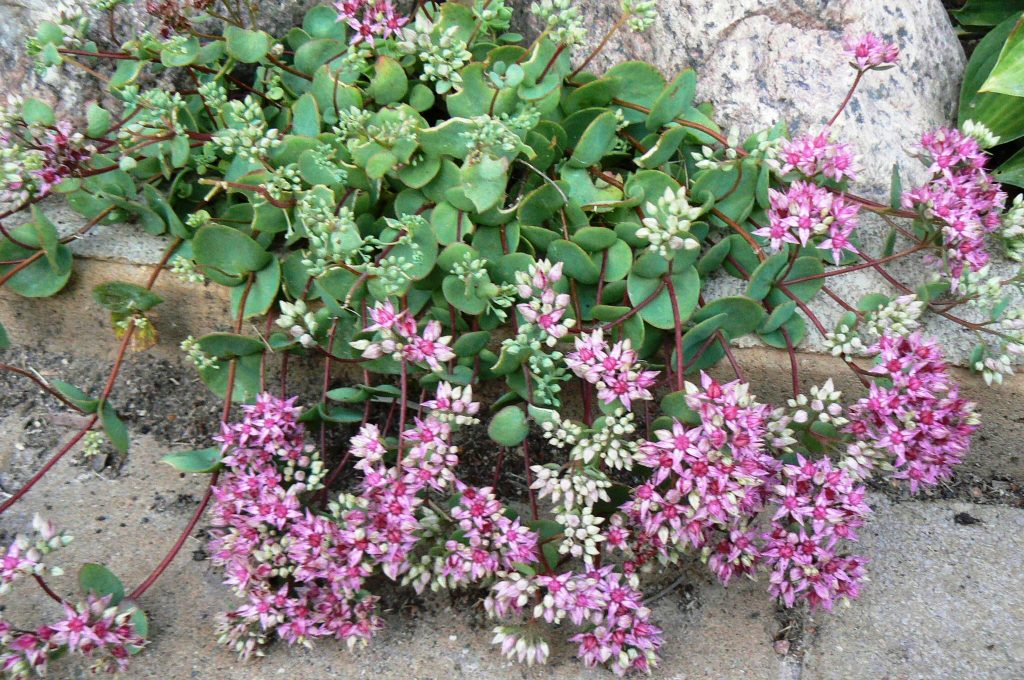
Sedum evers
It is better to refuse seedlings with sluggish stems and leaves, covered with yellow or black and brown spots.
After purchase, the plant is kept in quarantine. Three weeks are enough to determine their condition - whether they are sick with something or not. In the case of infections or parasites, it is necessary to treat with fungicides or insecticides, respectively.
When the stage of adaptation has passed and the sedum has faded, you can begin to transplant it to the site.
Some gardeners choose to buy seeds to grow. When buying, you should pay attention to their term, since expired seed will not rise.
Landing rules
Further growth and flowering of bushes depends on the right place and soil for planting.
The sedum loves diffused sunlight, but does not tolerate direct rays - foliage and buds quickly fade. You can plant flowers next to tall shrubs and other ornamental vegetation, which will create the necessary shade for lunch.
It grows poorly on acidified and waterlogged soil. The optimum depth of groundwater is 1 m. If the soil is acidic, it can be deacidified with chalk or slaked lime - 400 g of the substance is added per 1 m², then digging is carried out.
This plant prefers light and loose soil, flavored with compost or last year's manure. 10 kg of fertilizer is enough for 1 m². If the soil is clay, add sand, peat, perlite or vermiculite.
Landing technique:
- Dig holes at a distance of 40 cm with a distance in a row of 50 cm.
- Spill water, when moisture is absorbed, the roots are lowered, covered with earth, crushed around the stem, moistened again.
- To prevent the soil from drying out, the bushes are mulched with peat or rotted manure.
The necessary conditions
After planting, sedum must be provided with several vital conditions that will stimulate full growth and development.
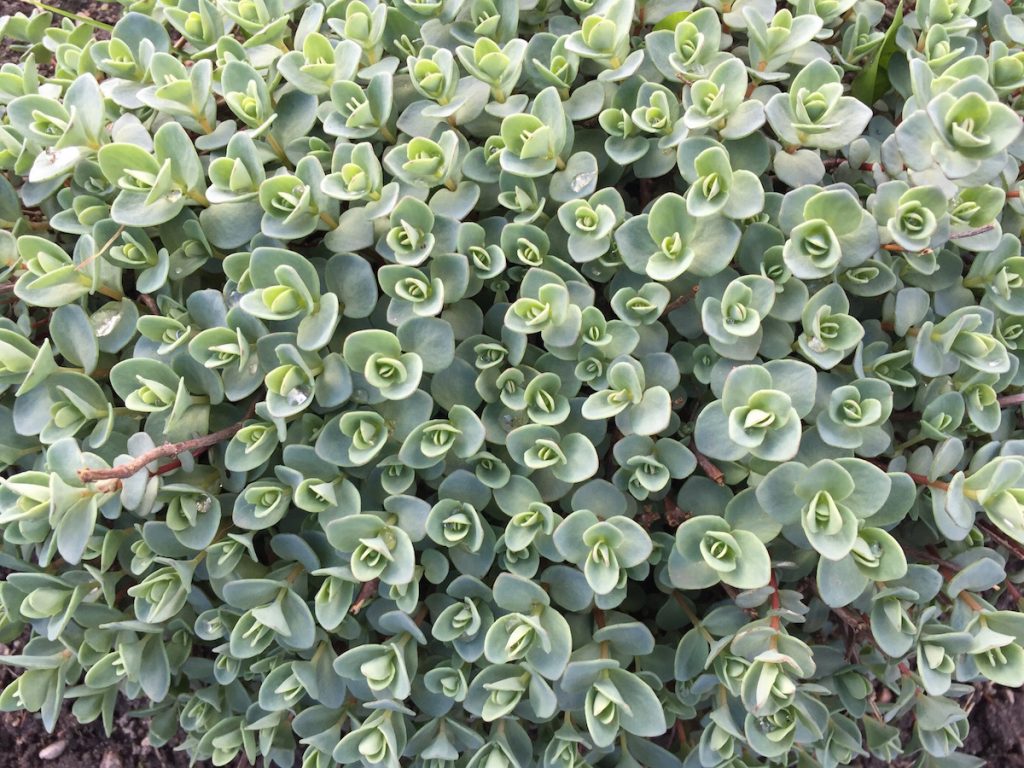
Sedum Eversa
In spring and summer, this decorative culture is regularly irrigated with warm water in the evening. On too hot days, the procedure is carried out every day, and closer to autumn it is stopped.
Sprinkling contributes to the rapid growth of green mass, maintains decorativeness and prevents the appearance of harmful insects.
The optimal duration of the light day during the growing season is 10 hours a day. Therefore, it is worth planting in the place where the sun shines in the morning and evening. This is enough for the plant to retain its decorative properties - to bloom brightly and magnificently.
Temperature
The sedum Evers belongs to the winter-hardy ones:
- in the warm season, there will be a comfortable mode in the range of 20-27 ° С.
- the plant successfully withstands a decrease to -30 ° C, therefore it is suitable for cultivation in all regions of our country.
The flower does not tolerate gusts of wind, especially in winter, from them the aboveground part can freeze. Therefore, it is better to plant it in a place protected from the winds.
Care features
In the process of growing a garden perennial, it is necessary to ensure regular moisture, nutrition, pruning, loosening and weeding. For this he will thank you with strong immunity and high decorative effect.
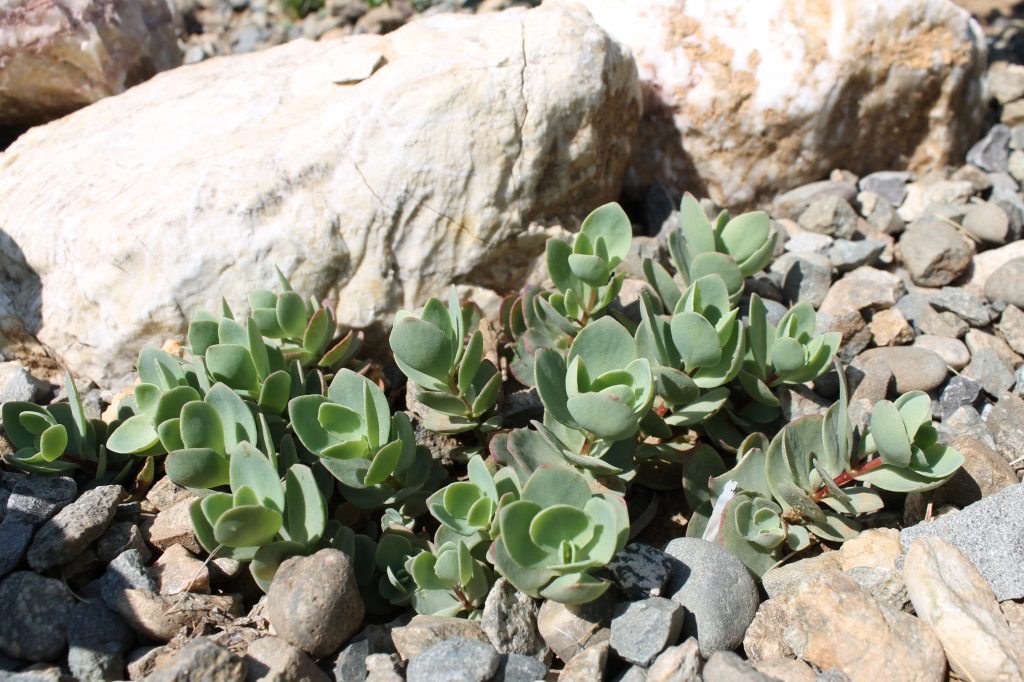
Sedum evers photo
Watering
From spring to the end of summer, the bushes are watered as the soil dries to a depth of 3-4 cm. 2-3 liters of water are poured under each plant.
Sedum Eversa does not tolerate frequent waterlogging, to which it can react with rotting roots. Therefore, watering is regulated taking into account seasonal precipitation. In the fall, watered less often - once every 10 days.
Loosening and mulching
After each moistening, it is necessary to loosen the soil so that it freely passes water and oxygen to the roots. Together with this procedure, the soil is weeded between the rows, weeds are removed, which take away moisture and nutrients from the plants.
Additionally, the near-trunk zone is mulched with peat, compost or last year's manure. Mulch prevents the growth of unnecessary vegetation and retains moisture in the soil.
Top dressing
In the first two years, sedum, planted in fertile soil, does not need food. Starting from three years, it is fertilized twice - before flowering and after the end. Mineral complex formulations are used in liquid form, intended for succulents. The dosage for preparing the solution is indicated on the package.
To improve the quality of flowering at the budding stage, you can feed it with potassium preparations.
Closer to autumn, humus or compost is embedded in the soil between the rows.
All root nutrition is combined with watering to improve the absorption of nutrients.
Pruning
Miniature compact plant does not require crown correction. Sanitary pruning is necessary - during the entire growing season, non-viable parts are cut out - stems, leaves that have turned yellow, dried out or have been affected by diseases, pests.
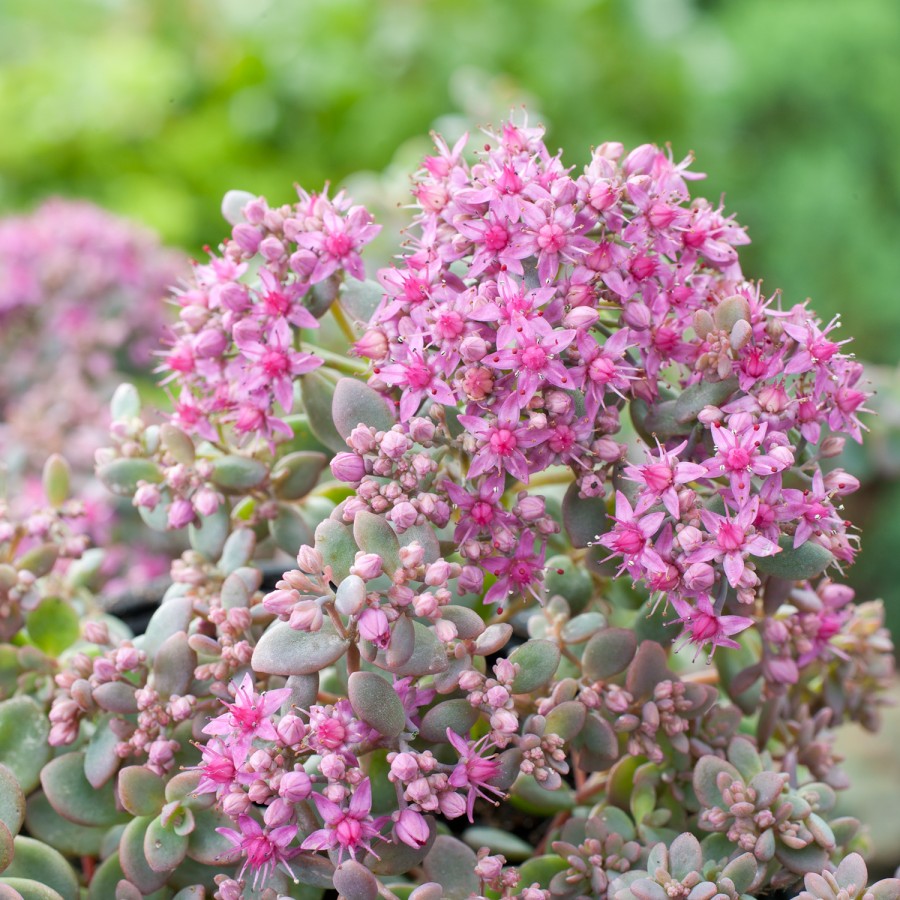
Sedum ewersii
Preparing for winter
Frost-resistant perennial tolerates any frost well, therefore, at a mature age (from three years), it does not need shelter.
It is advisable to insulate young seedlings. A month before the onset of stable autumn cold weather, the bushes are mulched with a thick layer of peat, they cover the aboveground part with burlap or spruce branches. The insulation is removed in the spring, when the snow thaws and the threat of return frosts has passed.
Transfer
This procedure is necessary for purchased plants immediately after the end of flowering.The bush is watered abundantly, the root system is removed and, together with an earthen lump, is transferred into a previously prepared hole in the garden. They fill up the earth to the top, tamp it, moisten it.
Also, flowers that grow in one place for a long time need regular transplantation. Change of soil for stonecrop is carried out every three years.
Unscheduled replanting is necessary for flowers with root system damaged by diseases or rot. The plant is watered abundantly, dug out, and the roots are washed from the ground under running water. All infected places are cut out, powdered with charcoal, dried and planted in another corner of the flower garden.
Reproduction methods
Sedum can be propagated in several ways, each with advantages and disadvantages.

Sedum evers landing and leaving
Cuttings
The most reliable and easy breeding method. Cut the cuttings in spring or summer. Strong and healthy stems are selected, cut off with a sharp and sterile instrument. The length of the segments should be at least 10 cm. In the lower part, remove all the foliage, lower it into a container with water with the addition of Epin.
After about 10-14 days, they will release the roots. Until this point, it is advisable to periodically change the water to prevent the appearance of mold.
Saplings with roots are planted in open ground with fertile and loose soil. The seeding depth is 3-4 cm, the distance between the shoots is 35-40 cm. Watered with warm water, spud.
Until the moment of rooting (10-15 days), they are shaded at noon so that they do not burn and dry out.
Seeds
Reproduction from seeds is a painstaking and not always justified process. Seeds are sown in autumn in not tall boxes or containers filled with a peat-sand mixture (1: 1). Before planting, the seeds are soaked for half an hour in a strong solution of potassium permanganate. Lay out on the surface, sprinkle with a thin layer of substrate, sprinkle with warm water from a spray bottle.
In order for the seedlings to germinate successfully, they are placed on a warm windowsill with diffused daylight, covered with a transparent film.
Every day the crops are ventilated, if necessary, sprayed. As soon as greenery appears on the surface of the soil, the shelter is removed, and continue to moisten.
At the stage of the appearance of a pair of leaves, a pick is carried out in separate containers. They grow for another 3-4 weeks at home, then they are planted in a flower garden.
By dividing the bush
This method is used when you need to rejuvenate old sedum. They moisten it, after an hour they carefully dig it out, wash off the earth from the roots. Divide with a sharp and sterile tool into parts, so that each division has one shoot and 2-3 roots.
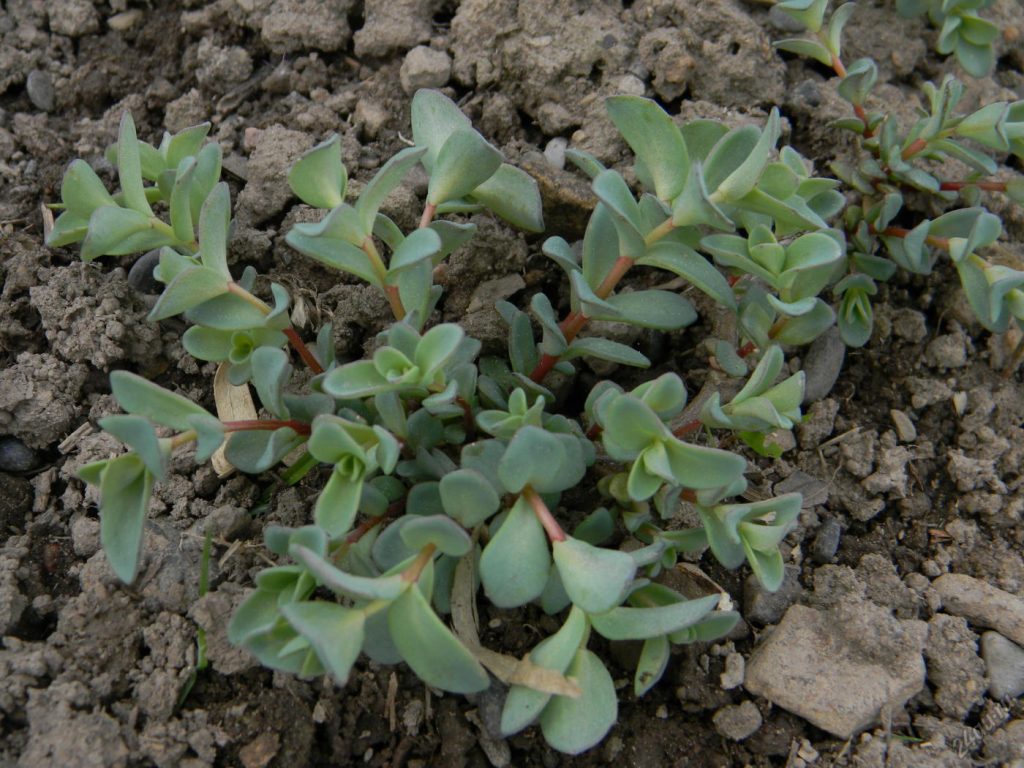
Sedum Eversa photo
Places of cuts are irrigated with a fungicide, dried, planted separately in fertile soil. Watered, sprinkled with peat.
Diseases and pests
Throughout the entire period of growth and development, this perennial sedum can be damaged by various sores and parasites, especially if the rules of maintenance and care are violated.
| Diseases and pests | Symptoms | Treatment methods | Prophylaxis |
| Aphid | It settles in colonies on the underside of leaves, feeds on their sap. The leaves begin to curl, dry out and crumble | At the initial stage, the lesion can be treated with a solution of laundry soap - 40 g per 1 liter of water. Heavily infested bushes are irrigated with Actellik or Karbofos | Weed regularly between rows, avoid thickening of plantings, remove weeds in a timely manner |
| Sawflies | The offspring of this pest - the caterpillars gnaw passages in the foliage, eat the buds. The infected plant quickly withers and dries up | Treatment of the crown and soil under it with Aktellik or other insecticides | Dig up the ground every autumn, irrigate the bushes with insecticides for prevention in early spring and late autumn |
| Root rot | From frequent waterlogging with cold water, the root system begins to rot. Over time, the infection spreads to the lower part of the stems - they darken, become soft and slippery | It is almost impossible to save a plant with rotten roots, therefore, several cuttings are cut for rooting, and the old bush is disposed of | Avoid overflow, use warm water for irrigation |

